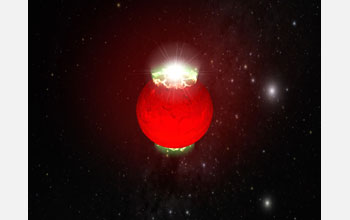Multimedia Gallery
Radio Pulsations From Ultracool Dwarfs
Radio pulsations from ultracool dwarfs. An artist's impression of the "super-aurorae" present at the magnetic poles of these radio emitting dwarfs which are responsible for the radio pulsations.
More about this Image
Brown dwarfs occupy the mass gap between planets and stars and are thought to be one of the most populous objects in our galaxy. They have a mass below that necessary to maintain hydrogen-burning nuclear fusion reactions in their cores and are therefore much cooler and dimmer than main sequence stars. This makes them very difficult to detect and, although astronomers have known of their existence for decades, it wasn't until 1995 that a brown dwarf was finally found.
In recent years, it has been discovered that these brown dwarfs can be extremely bright sources of radio emission. Up until now, it has been unclear how these failed stars can produce such high levels of this nature of radiation. Initially it was assumed that it was the same kind of radio emission as that detected from stars, such as the sun. For such stars, the radio emission is produced by high-energy electrons in the star's corona, that are trapped spiralling in the star's magnetic field.
These discoveries were made using the National Radio Astronomy Observatory, a facility of the National Science Foundation operated under a cooperative agreement by Associated Universities Inc. (Date of Image: April 2007)
Credit: Gregg Hallinan, National University of Ireland, Galway
Images and other media in the National Science Foundation Multimedia Gallery are available for use in print and electronic material by NSF employees, members of the media, university staff, teachers and the general public. All media in the gallery are intended for personal, educational and nonprofit/non-commercial use only.
Images credited to the National Science Foundation, a federal agency, are in the public domain. The images were created by employees of the United States Government as part of their official duties or prepared by contractors as "works for hire" for NSF. You may freely use NSF-credited images and, at your discretion, credit NSF with a "Courtesy: National Science Foundation" notation.
Additional information about general usage can be found in Conditions.
Also Available:
Download the high-resolution JPG version of the image. (421 KB)
Use your mouse to right-click (Mac users may need to Ctrl-click) the link above and choose the option that will save the file or target to your computer.

